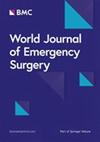Comparison between endovascular and surgical treatment of acute arterial occlusive mesenteric ischemia
IF 5.8
1区 医学
Q1 EMERGENCY MEDICINE
引用次数: 0
Abstract
The optimal strategy for initial treatment of acute occlusion of superior mesenteric artery (SMA) is debated. The aim of the study was to compare the effectiveness, timelines and outcomes of endovascular versus open surgical treatment in patients with acute SMA occlusion. This was a preplanned substudy of the prospective observational multicenter AMESI (Acute MESenteric Ischaemia) study. Patients with SMA occlusion were divided into surgical and endovascular treatment groups. The surgical group included patients initially subjected to open surgical treatment with surgical or hybrid revascularization or intestinal resection only. The endovascular group included patients initially revascularized endovascularly and was further divided according to treatment effectiveness. Patients were also categorized according to revascularization or no revascularization, and subanalysis performed for different revascularization methods. Baseline and outcome comparisons were made using Fisher and Mann–Whitney U tests. Risk-factors for in-hospital mortality were analysed using a logistic regression model. Of 158 patients 107 had surgical and 51 endovascular treatment. The surgical group had higher baseline illness severity scores, higher C-reactive protein and lactate values. The mortality in the endovascular effective, endovascular insufficient as monotherapy and surgical groups was 2.9%, 41.2% and 45.8%, respectively. In multivariable analysis surgery was not an independent risk factor for in-hospital mortality. The rate of arterial embolism was higher in the endovascular revascularization as monotherapy insufficient treatment group (10/17) compared to the endovascular revascularization as monotherapy effective (5/34) and surgical (27/107) groups. We could not identify useful best thresholds for discriminating between effective and insufficient endovascular treatment. Analysis comparing the effect of any revascularization versus no revascularization on in-hospital mortality did not show a clear benefit of revascularization and the method of revascularization did not independently influence mortality. The beneficial effect of endovascular compared to surgical treatment in unadjusted analyses is largely explained by selection of patients. None of the compared management approaches had an independent effect on mortality. The choice between endovascular and surgical treatment should not be based solely on the time elapsed from symptom onset but rather on the patient’s general condition and possibly on the cause of SMA occlusion.血管内与手术治疗急性动脉闭塞性肠系膜缺血的比较
急性肠系膜上动脉阻塞(SMA)初始治疗的最佳策略是有争议的。该研究的目的是比较急性SMA闭塞患者血管内与开放手术治疗的有效性、时间线和结果。这是前瞻性观察性多中心AMESI(急性肠系膜缺血)研究的一个预先计划的亚研究。将SMA闭塞患者分为手术组和血管内治疗组。手术组包括最初接受开放手术治疗的患者,手术或混合血运重建术或仅切除肠道。血管内组包括最初血管内重建的患者,并根据治疗效果进一步划分。根据血运重建术或无血运重建术对患者进行分类,并对不同的血运重建术进行亚分析。基线和结果比较采用Fisher和Mann-Whitney U检验。采用logistic回归模型分析住院死亡率的危险因素。158例患者中,手术治疗107例,血管内治疗51例。手术组有更高的基线疾病严重程度评分,更高的c反应蛋白和乳酸值。血管内有效组、血管内不足组和手术组的死亡率分别为2.9%、41.2%和45.8%。在多变量分析中,手术不是院内死亡率的独立危险因素。单药治疗不足组(10/17)动脉栓塞率高于单药治疗有效组(5/34)和手术组(27/107)。我们无法确定区分有效和不充分血管内治疗的最佳阈值。对任何血运重建术与非血运重建术对住院死亡率影响的比较分析没有显示出血运重建术的明显益处,血运重建术的方法也没有独立影响死亡率。在未经调整的分析中,与手术治疗相比,血管内治疗的有益效果在很大程度上是由患者的选择来解释的。没有一种比较的管理方法对死亡率有独立的影响。血管内治疗和手术治疗之间的选择不应该仅仅基于症状发作的时间,而应该基于患者的一般情况和可能的SMA闭塞的原因。
本文章由计算机程序翻译,如有差异,请以英文原文为准。
求助全文
约1分钟内获得全文
求助全文
来源期刊

World Journal of Emergency Surgery
EMERGENCY MEDICINE-SURGERY
CiteScore
14.50
自引率
5.00%
发文量
60
审稿时长
10 weeks
期刊介绍:
The World Journal of Emergency Surgery is an open access, peer-reviewed journal covering all facets of clinical and basic research in traumatic and non-traumatic emergency surgery and related fields. Topics include emergency surgery, acute care surgery, trauma surgery, intensive care, trauma management, and resuscitation, among others.
 求助内容:
求助内容: 应助结果提醒方式:
应助结果提醒方式:


